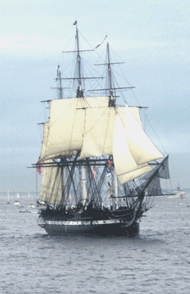 There were many privateers from Marblehead, with captains who received letters of marque from President James Madison, certifying their right to act as representatives of the United States government, to capture foreign ships and confiscate their cargoes. As many as four privateers a day weighed anchor and stood out from Marblehead. There was the Concordia, owned by the Blackler family and John Pedrick, the Orient, and the Betsey, which was taken off Newfoundland. The naval vessels Essex and Constitution listed many Marbleheaders among their crew, as did privateers from Salem. The War of 1812 was the last major war in which privateers were used, because this war emphasized the need for, and firmly established the U.S. Navy.
There were many privateers from Marblehead, with captains who received letters of marque from President James Madison, certifying their right to act as representatives of the United States government, to capture foreign ships and confiscate their cargoes. As many as four privateers a day weighed anchor and stood out from Marblehead. There was the Concordia, owned by the Blackler family and John Pedrick, the Orient, and the Betsey, which was taken off Newfoundland. The naval vessels Essex and Constitution listed many Marbleheaders among their crew, as did privateers from Salem. The War of 1812 was the last major war in which privateers were used, because this war emphasized the need for, and firmly established the U.S. Navy.
Danger during the War of 1812 to the town of Marblehead came from the sea, and Town Meeting responded accordingly. Fort Sewall, at the mouth of Marblehead harbor, had been neglected since the end of the Revolution, and had fallen into disrepair. The Fort was reinforced and armed once again. To protect Little Harbor, Fountain Park was fortified by a battery and designated Fort Washington. A forty-two pound cannon was placed at Skinner’s Head (now Glover’s Landing), smaller cannons at Goodwin’s Head and Gilbert’s Heights, and guards were stationed on Marblehead Neck.
Much of the fighting in the War of 1812 took place on the Great Lakes, against Canadian, British and Native American forces. Fighting also took place in the southern United States and on the Gulf Coast. The great battle at Fort McHenry in Baltimore harbor was the inspiration for Francis Scott Key’s Star Spangled Banner. Andrew Jackson became a national hero for the Battle of New Orleans. Significant battles were fought at sea, and the small United States Navy distinguished itself against the British fleet, then considered the strongest in the world. Naval success in the War of 1812 changed the attitude of the world towards the United States.